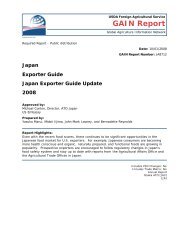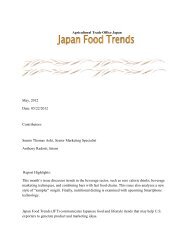Food Processing Sector Food Processing Ingredients Japan
Food Processing Sector Food Processing Ingredients Japan
Food Processing Sector Food Processing Ingredients Japan
You also want an ePaper? Increase the reach of your titles
YUMPU automatically turns print PDFs into web optimized ePapers that Google loves.
drinks and juices, and confectioneries have particularly benefited from this new trend. For<br />
instance, there are many alcoholic drinks that are targeted specifically to young women. While this<br />
personalization trend is becoming more and more common, it must be kept in mind that space is<br />
limited inside the <strong>Japan</strong>ese home. Refrigerators, cabinets, and food storage areas are small, as<br />
reflected in the packaging of almost all <strong>Japan</strong>ese food products.<br />
8. Twenties and Thirties<br />
While most food items have been introduced with a target demographic of homemakers, mainly<br />
women in their forties, there has been significant growth in food items targeted toward men and<br />
women in their twenties and early thirties. As the number of women in the workforce has grown,<br />
the age at which people are getting married is pushed back further. This trend coupled with more<br />
and more young professionals living outside their parents’ homes has resulted in a new<br />
demographic, especially for processed foods. These twenty and thirty year olds are looking for<br />
single portion meals that are easy to prepare and that fit their lifestyle. Products that are starting to<br />
appear are single serving pasta meals, where the directions are simple, the packaging is sleek and<br />
modern, and the pasta sauce choices available are gourmet in nature. These products use edgy<br />
advertising and often television commercials and celebrity endorsements to capture their audience.<br />
Packaging is a large portion of marketing to this demographic, which responds well to bright colored<br />
packaging with simple and modern themes. For example with wine, twenty and thirty year olds<br />
have basic knowledge about wine but not enough to differentiate quality. Much of the decisionmaking<br />
is based on price. Instead, when making a selection, it is a reasonable price (less than<br />
$10.00) and a brightly colored label with a bold slogan or interesting graphic that influences the<br />
purchase most. This new demographic has been receiving a great deal of attention because of their<br />
decisiveness in what they like, their willingness to spend money on what they like, and their brand<br />
loyalty.<br />
9. Beauty and Anti-aging<br />
Beauty and anti-aging products have always been popular in the <strong>Japan</strong>ese market, yet have<br />
remained mainly within the areas of cosmetics and pharmaceuticals. Along similar lines as<br />
functional foods, beauty and anti-aging is becoming a new marketing tactic within a growing aging<br />
population. This trend is showing large potential in the area of processed foods. While one approach<br />
is to educate the public on the natural anti-aging effects of some processed fruits and vegetables as<br />
well as juices, other companies have started to add anti-aging ingredients, such as collagen, to<br />
candies, beverages, and snack foods. The addition of these beautifying and anti-aging ingredients<br />
to food is becoming very popular among women of all ages. While this portion of the industry<br />
continues to grow, <strong>Japan</strong>ese regulations surrounding health claims are extremely strict. If you are<br />
looking to make beauty or anti-aging claims, please contact ATO <strong>Japan</strong> for information and ways to<br />
navigate this challenging set of <strong>Japan</strong>ese regulations.<br />
10. <strong>Food</strong> Safety<br />
<strong>Japan</strong>ese consumers are sensitive to food safety issues. Many <strong>Japan</strong>ese food processors demand<br />
that suppliers follow strict quality assurance procedures, including HACCP systems and traceability<br />
to the point of origin of the ingredients. <strong>Japan</strong>ese consumers are responsive to two concepts –<br />
Anzen – of safety, and – Anshin – peace of mind. It’s not enough for consumers to feel that<br />
product is safe, they demand that foods promote a peace of mind that is internalized. Merchants<br />
and retailers can always promote anzen, safety, but only time and reputation can bring on the<br />
feeling of anshin.<br />
C. PRODUCTS NOT PRESENT BECAUSE THEY FACE SIGNIFICANT BARRIERS<br />
1. Items Containing Prohibited <strong>Ingredients</strong> or Excess of Allowable Limits





